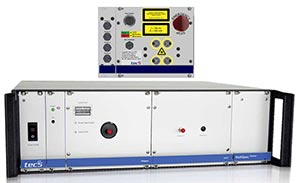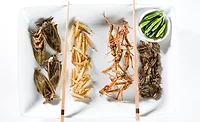CANNABIS PRODUCTS | JUNE 2019
Cannabis testing is an exact science - regulations are not

Courtesy of Agilent

Courtesy of PerkinElmer, Inc.

Courtesy of Waters Corporation

Courtesy of Shimadzu
In the U.S., there are 33 states, plus the District of Columbia, with some form of legal cannabis for medicinal purposes, and 10 states that allow it for recreational use—though it’s still illegal at the federal level. Canada recently legalized adult recreational use at the federal level through Health Canada.
But despite the advancing state of the legal cannabis industry, in the U.S., when it comes to specifying the level of tetrahydrocannabinol (THC), cannabidiol (CBD), terpenes and the other 80 or so constituent components in cannabis, there’s a smorgasbord of rules and regulations.
Find more cannabis processing equipment and packaged goods at foodengineeringmag.com
The legal situation is no better regarding contaminants and adulterants when cannabis is used as an ingredient in food and beverage. Rules governing maximum residual limits (MRLs) of mycotoxin and aflatoxin, chemicals/pesticides, heavy metals and bacteria in cannabis products are all over the map. And it’s not likely to change much until the federal government removes cannabis from its Schedule 1 classification under the Federal Controlled Substances Act (CSA) and the FDA takes over standardizing MRLs of toxins and establishing purity/dosing levels of THC. How does a producer or lab cope with all this variability?
At the federal level, there is a little forward movement. The 2018 Farm Bill allows the production and marketing of industrial hemp products and derivatives as long as they contain no more than 0.3 percent of THC on a dry-weight basis. These new regulations include removing these products from the CSA, which means that cannabis plants and derivatives that contain less than 0.3 percent of THC by weight are no longer controlled substances under federal law.
The FDA is finally getting involved—to a degree. FDA representatives recently met in a public forum hosted on May 31 to solicit oral presentations and comments in order to obtain scientific data and information about the safety, manufacturing, product quality, marketing, labeling and sale of products containing cannabis-derived products. Electronic comments can be submitted as late as July 2, 2019. For more information, visit “FDA Regulation of Cannabis and Cannabis Derived Products: Questions and Answers.”
In terms of test equipment, cannabis ingredient suppliers might only need a device that can be calibrated to test for known standards of THC, CBD and/or other cannabinoids. But sooner or later in the supply chain, much more extensive testing will be required to show that the cannabis product is safe to add to edibles and beverages. Fortunately, analytical instrumentation equipment that is well-known for testing contaminants and impurities in food and beverage products already exists and can be applied to cannabis testing.
While this equipment isn’t likely to be affordable to most producers, many cannabis testing labs have staff that know how to use these tools. Costs of tests typically run in the $50 to $250 range (depending on the test), and most results are returned within a day or two—what you’d expect with food testing. The only problem is that different states define their own levels for contaminants in cannabis, so these labs have their hands full training staff and working with samples requiring different measurements/assays.
Looking for quick answers on food safety topics?
Try Ask FSM, our new smart AI search tool.
Ask FSM →
Canada—A Focused Approach
In October 2018, Canada became the first G7 country to approve cannabis for medicinal and recreational purposes nationwide, says Narendra Meruva, principal marketing manager, Waters Corp., Milford, MA. Hemp cultivation in Canada has been authorized since 1998, and the country legalized medical cannabis in 2001.
Since Canada has legalized recreational cannabis for adults, consumer demand appears to be strong, says Anthony Macherone, senior scientist, Agilent Technologies, Santa Clara, CA. U.S.-based companies have made significant investment in Canadian cannabis companies, and countries such as Colombia and Denmark are expected to export cannabis to Canada. Continued growth is expected.
The cannabis industry in Canada must comply with regulatory guidelines and requirements defined by Health Canada (see “Cannabis industry guidelines and requirements” on the Health Canada website). Also, Canada requires batch-release quality control testing for potency and product safety testing for pesticides, mycotoxins, heavy metals, bacteria and molds. Other optional tests include residual solvents in oils prepared using solvent extraction and terpene profiling, Meruva adds. The new regulatory regime requires the same rigor whether products are destined for medical or adult-use markets.
Today, cannabis testing labs in Canada are focused on analyzing dried cannabis, oils and formulations. Legal cannabis edibles and beverages are expected to hit the market in Canada by fall 2019. As full legalization in Canada moves forward, regulatory agencies will continue to emphasize product safety, as well as implement more standards for laboratory accreditation—including method validation, ISO accreditation and mandatory proficiency testing.
The U.S.—A Hodge-Podge of Regulations
Cannabis regulations in the U.S. differ from state to state, and local governments are constantly writing and rewriting cannabis legislation, making it a big challenge for product testing laboratories to meet these changes as they occur, Meruva says.
Each U.S. state that has passed legislation for medicinal or recreational cannabis use has defined safety and quality testing requirements to mitigate consumer exposure to toxicants such as pesticides, mycotoxins, heavy metals, residual manufacturing solvents and microbial contaminates such as E. coli and Aspergillus, says Macherone. Other testing includes cannabinoid profiling and quantitation of the total potency of the product, as well as terpene profiling.
“It should be noted that each U.S. state has defined its own unique legislation,” Macherone says, “and there is very little to no interstate harmonization with respect to the required testing, the target chemical lists or the allowable levels.”
Even so, existing and new analytical labs are registering for cannabis testing licenses with state public health agencies, says Meruva. Labs are also building capacity to provide a full suite of safety and quality assurance tests required by regulatory agencies.
Unfortunately, Meruva says, due to lack of industry-standard methods and reference materials, there is a high lab-to-lab batch variability in reported analytical results. Therefore, it’s important to educate the industry about the complexity of testing cannabis ingredients and products.
“For commodity items such as apples, oranges and grapes, it is up to the EPA to set allowable tolerance levels in food for each different pesticide, and then up to the FDA and USDA to enforce those levels,” says Bob Clifford, Ph.D., general manager, Shimadzu Scientific Instruments, Columbia, MD.
However, since cannabis is illegal at the federal level, no such tolerances exist. In Europe and some U.S. states, the working term is “maximum residual limits.” Therefore, it’s up to each individual state to determine which pesticides can or can’t be used, and at what levels they can exist on foods and beverages. This not only applies to pesticides, but also to heavy metals, residual solvents, mycotoxins/aflatoxins, microbial, and moisture or water activity.
For example, Clifford notes, Colorado and Nevada only monitor 15 and 24 pesticides, respectively. Oregon was one of the first states with a larger list, containing 59 pesticides. As California was developing its pesticide list, it looked at the lists of those three states and added more to bring the total number of pesticides to 66.
When Canada developed its pesticide list, it looked at the lists of the U.S. states and decided on a total of 96. Canada’s literature indicates the list will likely evolve, and it has with AOAC International. AOAC is working on a method with 104 pesticides, and the MRLs will be 50 percent lower than any other state or country.
Because the Canadian market can import and export, regulators there look closely at Europe to align pesticide thresholds, says Toby Astill, Ph.D., food market manager, cannabis and hemp, PerkinElmer, Victoria, British Columbia. That’s why Canada has, one of the longest, most sensitive lists of pesticides in the market, with 96 pesticides down to 20 ppb, he notes.
Heavy metals isn’t as complicated, Clifford says. For states that require heavy metals testing, they usually include the “big four” of arsenic, cadmium, lead and mercury. However, Maryland adds barium, chromium, selenium and silver to the list. New York includes the big four, plus antimony, copper, nickel and zinc.
MRLs of solvents used to extract cannabinoids and terpenes also vary by state, Clifford says. Maryland has a list of eight residual solvents, whereas Oregon has a list of 45 solvents. At the same time, New York has zero tolerance for conventional solvents, since it allows only the use of supercritical fluid extraction (e.g., CO2) for cannabinoids and terpenes, which are also tested.
The cannabis industry continues to evolve regarding safety, but it would be very difficult for some states to have a full suite of methods for testing without shutting the industry down due to the lack of resources or expertise, Clifford says. For example, one antifungal pesticide, myclobutanil, is used extensively in produce, such as almonds (100 ppb), apples (500 ppb) and grapes (1,000 ppb), and has had a risked-based tolerance set by EPA. However, when used in cannabis and heated during decarboxylation (to activate the THC), a toxic hydrogen cyanide gas is consumed. This can cause serious health effects, especially to patients already being treated for health problems. So the industry must set distinct testing parameters to account for cannabis-specific risked-based tolerances.
A Model Lab
Cannabis testing provides assurances to the public that the products they are buying are safe to consume, says Meruva. Consumers are looking for more information to support their purchase decisions. Relying on the amount of THC or CBD in a product is not sufficient. Understanding the concentration of the cannabinoids and the profile of the terpenes enables consumers to have a predictable experience from the products that they purchase.
Macherone notes seven common tests that a U.S. state may require as part of its safety testing program: potency, terpenes, pesticides, mycotoxins, heavy metals, residual manufacturing solvents and microbial contaminates. However, not all states require all seven, and each state generally defines the chemicals and biological species that comprise its target list and “action levels.” There is very little empirical evidence for how these target lists and action levels are determined.
Currently, there is a lack of harmonization in cannabis safety and quality standards between different regions, Meruva says. The tolerance levels for pesticide detection in cannabis can range from low parts per billion to low parts per million. Cannabis industry stakeholders are working with standardization groups such as AOAC and the ASTM International D37 committee to harmonize testing requirements and methodologies for cannabis testing laboratories.
Equipping the Lab
Requirements for a complete analytical test lab include a full suite of analytical instruments, says Clifford. The class of compounds tested most often is cannabinoids, usually done by a “cannabis analyzer” instrument based on the gold standard of high-performance liquid chromatography (HPLC). Most labs test between 5 to 16 cannabinoids.
A LC-MS (liquid chromatographic, mass spectrometer) or LC-MS/MS (tandem mass spectrometers), can be used as well, says Clifford. However, the LC-MS/MS requires a higher level of expertise to operate, has a lower linear dynamic range, and requires greater calibration frequency and switching sources.
A fully equipped cannabis testing lab will have chromatographic, mass spectrometric and biological testing instrumentation, says Macherone. These include, for example, HPLC, LC- and GC- (gas chromatographic) triple quadrupole MS (mass spectrometric), inductively coupled plasma mass spectrometry (ICP-MS), and PCR (polymerase chain reaction) equipment for DNA/RNA sequence testing.
The use of LC and GC techniques, coupled with MS detection to achieve the highest-possible sensitivity for food and clinical research applications, can also be applied to cannabis testing, Meruva says. Other testing capabilities include analysis of elemental compositions using ICP-MS, as well as screening for microbiological contaminants and pathogens.
Waters recommends using ultra performance LC (UPLC) systems for fast potency analysis under 10 minutes to reduce analysis time—compared to HPLC testing—without compromising analytical results. Comprehensive pesticide analysis requires the use of both LC-MS/MS and GC-MS/MS to screen and quantitate trace-level pesticides and ensure that chemicals used during cultivation do not make their way into the finished cannabis edibles and beverages offered for retail sale.
“Pesticide compounds have different molecular weights, polarities, volatiles, thermal stabilities and ionization efficiencies, and some are better suited for analysis by LC-MS/MS, whereas GC-MS/MS is a better technique for others,” Clifford says.
Mycotoxins/aflatoxins analysis can also be performed on the LC-MS/MS, adds Clifford. The states that require this test specify analysis of aflatoxins B1, B2, G1 and G2, as well as mycotoxin ochratoxin A. This analysis can often be done when testing for pesticides.
If a lab uses a GC-MS/MS for pesticide analysis, it’s important to know that the system can also be used for analysis of terpenes and residual solvents. Some labs use the less expensive GC or GC-MS for these analyses; however, a GC-MS/MS instrument offers the advantage of providing a “fingerprint” of the compounds, whereas GC compounds are only distinguished by retention time.
Heavy metals require an ICP-MS for the analysis of the big four metals of arsenic, cadmium, lead and mercury. Because of the ICP-MS sensitivity and flexibility, more elements can easily be added to the sample analysis without increasing run time, sample preparation or cost.
Moisture analysis requires a moisture balance or water activity meter—or both, depending on the state. Moisture analysis is tested because a too-dry product will crumble and have poor quality, while too much moisture provides the ideal conditions for mold growth.
While most lab hardware includes software fine-tuned for the measurements that need to be made, other tools like QMS and QA/QC are good investments.
“We are seeing a movement toward more producers and manufactures including a QMS (quality management system) and QA/QC program to meet the demanding testing and market drivers,” says Astill. “This results in more internal laboratories that require a similar suite of instrumentation to test the product before the final test is set out to a third-party lab. Multiple financing options are now available in the industry, which allow better accessibility to lab equipment for these tasks.”
Equipment and Operation
Analyzers for cannabis ingredient potency are often straightforward to operate. For example, Shimadzu’s Cannabis Analyzer for Potency comes with all necessary information, chemicals and methods. This device was designed for the non-scientist. All that’s required is basic computer spreadsheet knowledge. Users enter five parameters: sample name, sample ID, sample weight, extraction volume and dilution volume. The sample preparation manual is included, as are the HPLC, guard column, analytical column, methods, reagent and standards.
But, for anything beyond evaluating THC levels, a college-educated chemist with a strong analytical background is needed.
Typical employee skills required for a cannabis testing laboratory include a mix of analytical chemists and microbiologists, says Meruva. In any laboratory situation, operators need to be able to develop methods and troubleshoot problems when unexpected results arise. It can take a few years to be proficient in using these analytical techniques.
It really comes down to how much hands-on experience the operators have in using the equipment. If laboratory analysts are hired with less experience, then it’s helpful to have someone with experience who can train them, oversee their results and maintain their equipment.
A Case for Optical Spectroscopy
—Eric Rendon, Segment Manager for Precision Agriculture, Horticulture and Cannabis, tec5USA
 For analyses and precise measurement levels of THC, CBD and impurities—such as microbiological, mycotoxins and chemicals—the current industry standard is high performance liquid (HPLC), or gas chromatography (GC), mixed with mass spectroscopy (MS). While these instruments do provide a great analysis, they have their own limitations. HPLC/MS, for example is expensive to purchase and maintain, and operation requires a high sophistication in analytical chemistry. Furthermore, these methods destroy the sample. As a result, only a small amount of product is generally tested to represent the quality of a much larger amount.
For analyses and precise measurement levels of THC, CBD and impurities—such as microbiological, mycotoxins and chemicals—the current industry standard is high performance liquid (HPLC), or gas chromatography (GC), mixed with mass spectroscopy (MS). While these instruments do provide a great analysis, they have their own limitations. HPLC/MS, for example is expensive to purchase and maintain, and operation requires a high sophistication in analytical chemistry. Furthermore, these methods destroy the sample. As a result, only a small amount of product is generally tested to represent the quality of a much larger amount.
Optical spectroscopy is a fast, non-destructive method that can perform various analyses. Optical spectroscopy works by first shining light on a sample of interest. Depending on the type of optical spectroscopy used, a detector will measure the amount of light absorbed by the sample, or the way in which light scatters when encountering the sample. Since each chemical compound displays its own unique spectrum, these techniques can be used to determine various qualities of a sample, such as concentrations of its components like THC and CBD. Because of the minimal sample preparation required and fast acquisition times, optical spectroscopy can be used to monitor multiple parameters throughout the production process, including extraction, measuring residual solvents, to the food, monitoring fats, proteins, sugars, etc., leading to a consistent, high-quality product. These methods are already readily used in agriculture, as well as in the food and beverage industry for in-line quality control measurements and will likely increase in popularity to ensure uniform product quality.









